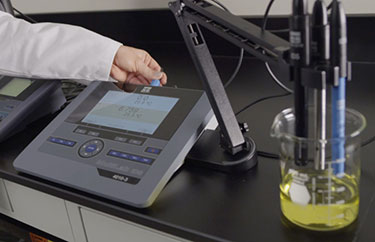pH Measurement Performance and GLP Compliance
A common question when selecting your pH meters and/or pH sensors should be "Is it GLP compliant?" GLP (Good Laboratory Practice) standards are guidelines set by government agencies to ensure the quality and integrity of the data you gather from your pH meter. It is important that your data is reliable, consistent, and accurate. There are qualifications to look for to guarantee your data will be just that when purchasing your next pH meter. 
Manufacturers of data collecting instrumentation like YSI and many of our sister companies must adhere to certain qualifications throughout the manufacturing process to give the credibility to say "our pH meter is GLP compliant."
The qualification process consists of up to four consecutive test stages. Ask your manufacturer about each one of these steps. Each stage is documented accordingly:
1) Design Qualification
The user formulates the requirements for the components and operating conditions in the design qualification phase prior to purchasing. Common requirements are the purpose of use, environmental conditions, technical data, and any "special" requirements based on the uniqueness of the application.
Documentation in this qualification step serves as proof that the instrument is designed and manufactured in accordance with GLP requirements and the user is receiving exactly what he or she needs.
2) Installation Qualification
This part of the qualification process is either conducted at the site of installation or duplicated at the manufacturing facility. This phase provides evidence that your pH meter meets the GLP specifications in the environmental conditions it will be used in. If this step is performed on the actual installation site, the completeness of the system and the environmental and application conditions are examined after delivery.
3) Operational Qualification
This stage is performed to check whether the installed system complies with the general conditions of the technical and functional specifications determined in the design qualification phase.
The device is tested at the point of use during operational qualification. A comparison with the technical data of the components or a test with a GLP standard may also be performed at this time. Specifically, pH measuring systems, in this stage of the quality check, are tested to determine the pH value of DIN buffer solutions after the calibration of the device.
4) Performance Qualification
The final qualification of your instrument demonstrates that the measurement system consistently provides a performance according to GLP specifications under real operating conditions. We suggest that the user continue to routinely perform this same performance qualification throughout the lifetime of the use of the instrument.
Conclusion
Individual tests of a pH meter and a pH electrode only provide a statement about the current functioning of the electrode and the pH meter as individual components, not as a complete system*.
Each step in the qualification process ensures the continuous GLP validity of pH measurements of the entire system.
The qualification beginning from the design qualifications prior to purchase, over the one-time installation and operational qualification at the on-site or duplication work facility up to the performance qualification, together, give you a guarantee that your complete pH measuring system (pH meter, pH electrode, pH buffer solutions) yield a consistent performance according to GLP specifications or standards under the specific conditions. In fewer words: Your instrument is GLP compliant! Your data will be reliable, consistent, and accurate!
*YSI provides specifications based on the complete system, not individual components.

Additional Blog Posts of Interest:
Extend the Life of Your pH Electrode in 3 Practical Steps
pH Meter Calibration Problems? Check Out These 12 Tips!
Why is the pH Scale Logarithmic?
Is pH the Measurement of Hydrogen Ion Concentration or Ion Activity?